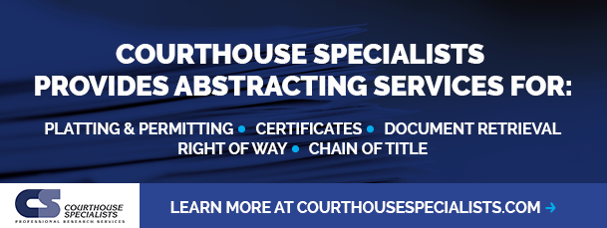 An easement is a property interest that gives someone the legal right to use or own parts of the property owner’s land. The person does not legally own or possess the land, but has the right to use it through an agreement with the owner. An easement does not enable the easement holder to exclude others from the property or occupy the land. The property owner may exclude anyone but the easement holder from the land. Understanding how easements may affect your property and its value can prevent major headaches as a landowner down the road.
An easement is a property interest that gives someone the legal right to use or own parts of the property owner’s land. The person does not legally own or possess the land, but has the right to use it through an agreement with the owner. An easement does not enable the easement holder to exclude others from the property or occupy the land. The property owner may exclude anyone but the easement holder from the land. Understanding how easements may affect your property and its value can prevent major headaches as a landowner down the road.
Utility Easement
A utility easement is a common type that gives local utility companies the right to use parts of a piece of land. There may be pre-existing utility easements on a property at the time of purchase. Utility easements are necessary for the existence of electricity, television, telephone, water, and sewer systems on the property. Utility easements exist for the benefit of the community, as it is more efficient and cost effective to run utility lines straight through a neighborhood rather than around individual pieces of property.
This easement does not give utility companies free rein to do as they wish on your property, but they may do things for the good of the community. For example, the company may install underground lines or utility poles without your permission. The easement also restricts what you may do to your property. You could not, for example, plant a tree so that it will directly interfere with power lines. Utility easements generally don’t affect the value of a property unless it imposes tight restrictions on what the property owner may and may not do.
Public Easement
In some areas, the general public has the right to use certain areas, streets, and paths. In these cases, a public easement would give the public the right to use a part of the property. This may be the case in the event of protected land, such as a reservation or park. A public easement may also be necessary to establish a parking lot or touring location. Public easements often come into play when the government dedicates certain areas of land for public use.
In some cases, public easements appear after years of the public using an area of private property. For example, beach access paths that are technically on private land, but have been used by the public for years, may be subject to such public easements. Whether the public easement affects property value depends on how much access the public has to the land, and how this restricts property ownership and changes to the land. If many homes in the neighborhood have the same public easements, conditions would be normalized, therefore not likely to decrease property value.
Private Easement
A private easement is one the property owner sells to another individual. Private easements often help neighbors during building and development. For example, if your neighbor wants to use your land for solar access or install pipes beneath your home for proper sewer access. Private easements will generally not interfere with property ownership. It’s up to the landowner to agree or refuse to sell the private easement.
Before purchasing a piece of property, inspect any private easements listed on the title. Review copies of the actual easement documents to learn where they are and what uses/restrictions they require. Private easements may limit what you can build or install on your property based on the terms. The previous owner may not have had an issue with the easement’s restrictions, but you might not be happy with what you can and cannot do because of your neighbor’s legal right to the property.
Easement by Necessity
Sometimes easements are unavoidable; for example, a neighbor who has to cross through your property to get to his/her own house. In situations where access to a piece of land must go through your private property, an easement by necessity may come into existence. The property owner does not have the right to stop these easements, as this would encroach on the neighbor’s legal rights. Where land gets divided, easements by necessity occur the most often.
Easement by Prior Use
Occasionally previous landowners have easements from divided pieces of property but forget to include them on titles and deeds. If another person were to purchase this land, he or she would not see any easements on the property – only to find that a neighbor uses part of the property for one reason or another. If a landowner forgets to include an easement in the deed, he/she must prove the existence of the easement by prior use. To establish this type of easement, the property owner needs to show common ownership of two properties at one time, a severance of the properties, easements before and after the severance, notice of the easement, and that the easement is necessary.
Prescriptive Easement
In some cases, an individual needs another’s land for a specific purpose. For example, using the driveway for accessing the individual’s own home or a path that acts as a shortcut. If this is the case, the individual can receive an easement by using or occupying the land for a set number of years. The minimum amount of time varies from state to state. It may take 10 or 20 years of using the other person’s land to receive a prescriptive easement. The timeline is often the same for adverse possession, or when someone gains legal property ownership by occupying the land.
A prescriptive easement differs from adverse possession in a few important ways. The government does not require property taxes on a prescriptive easement claim, but may require trespassers to pay taxes on land they legally own by occupation. The trespasser doesn’t have to be the only one using the land to receive a prescriptive easement – more than one person can acquire these easements on the same piece of land. A property owner can prevent a prescriptive easement by giving the individual the right to use the property.
The Takeaway
There are many types of easements that may exist on a single piece of property. Conducting an in-depth public records search on the property can help potential landowners learn of easements before making a purchase. In most situations, easements will not decrease the value of the property. If the easement has strict rules or requirements the property owner must follow, however, it can affect property value and marketability. The more you know about the easements on a property, the more informed you’ll be as a buyer.






















